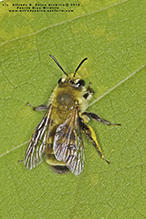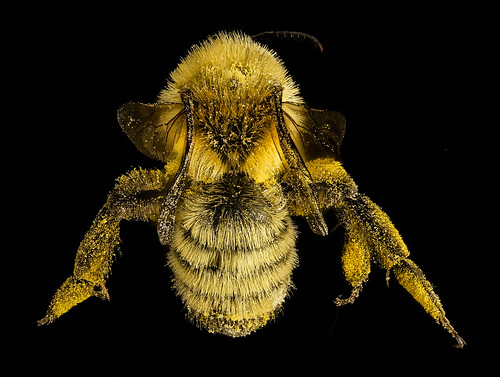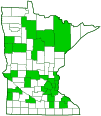hairy-banded mining bee
(Andrena hirticincta)
Conservation • Description • Habitat • Ecology • Distribution • Taxonomy
Conservation Status |
|
|||||||
| IUCN Red List | not listed |
|||||||
| NatureServe | NNR - Unranked SNR - Unranked |
|||||||
| Minnesota | not listed |
|||||||
Description |
||
Hairy-banded mining bee is an easily recognized, late season, mining bee. It occurs in the United States from Maine to Idaho south to Tennessee and New Mexico, and in Nova Scotia, Quebec, and Ontario, Canada. It is common in Minnesota. It appears in late summer when its preferred pollen sources, Solidago and Euthamia, are in bloom. Hairy-banded mining bee is often mistaken for a bumble bee. Females are 7⁄16″ to ½″ (11 to 13 mm) long. Males are more slender and a little smaller, 5⁄16″ to ⅜″ (8.5 to 10 mm) long. Both sexes are densely covered with long hairs that are lemon-yellow with a slight greenish tinge. There are two large compound eyes on the sides of the head and three simple eyes (ocelli) in a triangle on top of the head. The compound eyes are distinctly vertical. The inner margins are straight up and down and close to parallel. Next to the inner margin of each compound eye there is a slight depression (fovia) out of which emerges a dense band of pale hairs. The face is wider than long. The tongue is short and pointed. The finger-like sensory organs (labial palps) attached to the mouth have four segments. All of the segments are cylindrical and about the same length. The antennae of the male have 11 segments (flagellomeres) beyond the scape and pedicel. The female antennae have 10 flagellomeres. There are two grooves (subantennal sutures) below the base of each antenna, though these cannot be seen without careful handling and possibly also a microscope. The thorax is densely covered with long, erect, yellow hairs. The female has six abdominal segments, the male has seven. On both sexes there is a dense band of erect yellow hairs at the rear margin of each segment. The forewings are mostly clear but moderately darkened toward the tip. The marginal cell is relatively long and is pointed (narrowly rounded) at the tip. There are three submarginal cells. The second submarginal cell is much shorter than the first and third. The basal vein is nearly straight. The broad lobe at the base of the hindwing (jugal lobe) is longer than the narrow cell adjacent to it (submedian cell). |
||
Size |
||
Female: 7⁄16″ to ½″ (11 to 13 mm) Male: 5⁄16″ to ⅜″ (8.5 to 10 mm) |
||
Similar Species |
||
Habitat |
||
Prairies, weedy fields |
||
Ecology |
||
Season |
||
One generation per year: August to October |
||
Behavior |
||
|
||
Life Cycle |
||
The female creates a vertical tunnel in the ground with side tunnels branching off. Each side tunnel is a cell that contains a single egg and is provisioned with a ball of pollen mixed with nectar. |
||
Larva Food |
||
Pollen mixed with nectar |
||
Adult Food |
||
Pollen of goldenrods in the genera Solidago and Euthamia. |
||
Distribution |
||||
|
Sources |
|||
| 8/1/2023 | ||||
Occurrence |
||||
Common |
||||
Taxonomy |
|||
Order |
Hymenoptera (ants, bees, wasps, and sawflies) | ||
Suborder |
Apocrita (narrow-waisted wasps, ants, and bees) | ||
Infraorder |
Aculeata (ants, bees, and stinging wasps) | ||
Superfamily |
Apoidea (bees and apoid wasps) | ||
| Epifamily | Anthophila (bees) | ||
Family |
Andrenidae (miner, fairy, allied panurgine, and oxaeine bees) | ||
Subfamily |
Andreninae (typical mining bees) | ||
Tribe |
Andrenini | ||
Genus |
Andrena (mining bees) | ||
| Subgenus | Cnemidandrena | ||
Synonyms |
|||
Anthrena americana Andrena fimbriata |
|||
Common Names |
|||
hairy-banded andrena hairy-banded mining bee hairy-belted mining bee shaggy golden rod mining bee |
|||
Glossary
Flagellomere
A segment of the whip-like third section of an insect antenna (flagellum).
Ocellus
Simple eye; an eye with a single lens. Plural: ocelli.
Palp
Short for pedipalp. A segmented, finger-like process of an arthropod; one is attached to each maxilla and two are attached to the labium. They function as sense organs in spiders and insects, and as weapons in scorpions. Plural: palpi or palps.
Scape
In plants: An erect, leafless stalk growing from the rootstock and supporting a flower or a flower cluster. In insects: The basal segment of the antenna.
Scopa
A brush-like tuft of hairs on the legs or underside of the abdomen of a bee used to collect pollen.
Tegula
A small, hardened, plate, scale, or flap-like structure that overlaps the base of the forewing of insects in the orders Lepidoptera, Hymenoptera, Diptera, and Homoptera. Plural: tegulae.
Visitor Photos |
|||||
Share your photo of this insect. |
|||||
| This button not working for you? Simply email us at info@MinnesotaSeasons.com. Attach one or more photos and, if you like, a caption. |
|||||
Alfredo Colon |
|||||
 |
|||||
MinnesotaSeasons.com Photos |
|||||
|
|||||

Slideshows |
||
| Andrena hirticincta USGS Bee Inventory and Monitoring Lab |
||

|
||
About
Shaggy Golden Rod Mining Bee |
||
| Andrena hirticincta Isaacs Lab at MSU |
||

|
||

Visitor Videos |
|||
Share your video of this insect. |
|||
| This button not working for you? Simply email us at info@MinnesotaSeasons.com. Attach a video, a YouTube link, or a cloud storage link. |
|||
Other Videos |
|||


Created: 2/19/2020
Last Updated:

